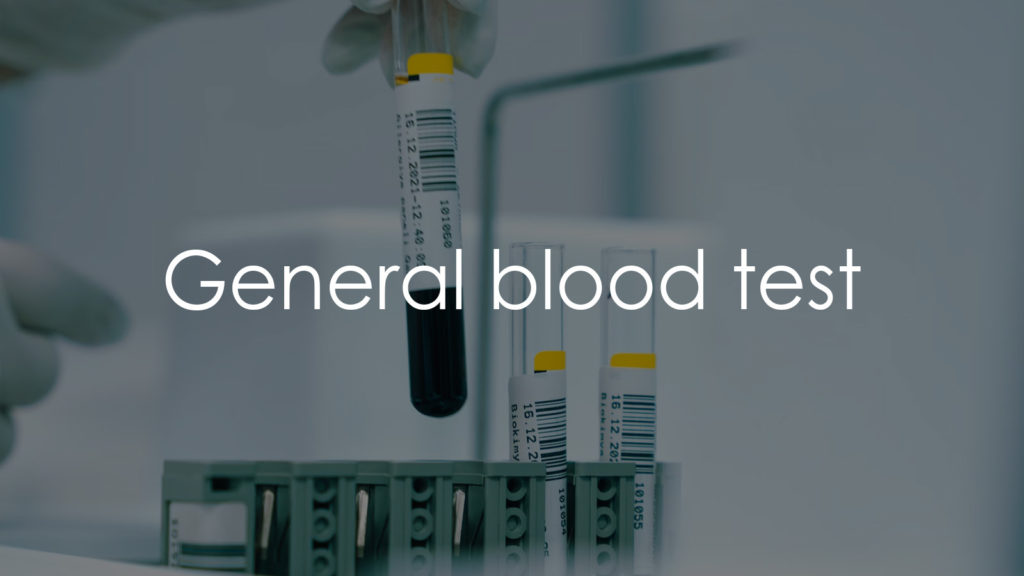A general blood test, also known as a complete blood count (CBC), is a common and essential diagnostic tool in medicine. It provides a detailed overview of various components of the blood, including red blood cells, white blood cells, hemoglobin, hematocrit, and platelets. This test is crucial for diagnosing a wide range of conditions, monitoring health status, and guiding treatment decisions. In this article, we will discuss the purpose of a general blood test, the procedure for conducting it, the interpretation of results, and what to consider when receiving the final report.

Why is it needed?
A general blood test is necessary for several reasons, including:
- Diagnosing Medical Conditions: It helps in identifying a variety of health issues, such as anemia, infections, inflammation, bleeding disorders, and leukemia.
- Monitoring Overall Health: Regular blood tests can track the status of chronic conditions, such as diabetes or cardiovascular diseases.
- Assessing Nutritional Status: It can detect deficiencies in vitamins and minerals, such as iron, vitamin B12, and folate.
- Evaluating Immune System Function: The test measures white blood cells, which are crucial for immune response.
- Preoperative Assessment: Ensuring patients are fit for surgery by evaluating their overall health and detecting any underlying conditions.
- Medication Monitoring: Assessing the impact of medications on blood cell counts, particularly in treatments like chemotherapy or anticoagulants.
Procedure for taking the test
The procedure for a general blood test is straightforward and involves several steps:
- Preparation: Patients are usually advised to fast for 8-12 hours before the test, especially if additional tests (like glucose or cholesterol) are being conducted. Drinking water is allowed.
- Sample Collection: A healthcare professional will clean the area with an antiseptic wipe and draw blood from a vein, typically in the arm. This process involves inserting a needle attached to a syringe or a vial.
- Processing: The collected blood sample is sent to a laboratory for analysis. Modern automated machines count and analyze the blood cells and their components.
- Completion: The entire process, from preparation to sample collection, takes only a few minutes. Results are usually available within a few hours to a couple of days, depending on the laboratory.
Decoding the results
Interpreting the results of a general blood test involves examining various components of the blood. Here are the key elements and what they signify:
Red Blood Cells (RBCs)
- Normal Range: Approximately 4.7 to 6.1 million cells per microliter for men, and 4.2 to 5.4 million cells per microliter for women.
- Significance: RBCs carry oxygen from the lungs to the rest of the body. Abnormal levels can indicate anemia, dehydration, or heart disease.
Hemoglobin (Hgb)
- Normal Range: 13.8 to 17.2 grams per deciliter for men, and 12.1 to 15.1 grams per deciliter for women.
- Significance: Hemoglobin is the protein in RBCs that carries oxygen. Low levels can suggest anemia, while high levels might indicate polycythemia or lung disease.
Hematocrit (Hct)
- Normal Range: 40.7% to 50.3% for men, and 36.1% to 44.3% for women.
- Significance: Hematocrit measures the proportion of blood volume occupied by red blood cells. Abnormal values can indicate anemia, dehydration, or other medical conditions.
White Blood Cells (WBCs)
- Normal Range: 4,500 to 11,000 cells per microliter.
- Significance: WBCs are crucial for fighting infections. Elevated levels can indicate infection, inflammation, stress, or leukemia. Low levels might suggest bone marrow problems, autoimmune conditions, or severe infections.
Platelets
- Normal Range: 150,000 to 450,000 platelets per microliter.
- Significance: Platelets are essential for blood clotting. Abnormal levels can point to clotting disorders, bone marrow issues, or severe infections.
Mean Corpuscular Volume (MCV)
- Normal Range: 80 to 100 femtoliters.
- Significance: MCV measures the average size of RBCs. High MCV indicates macrocytic anemia (often due to B12 or folate deficiency), while low MCV suggests microcytic anemia (often due to iron deficiency).
Mean Corpuscular Hemoglobin (MCH)
- Normal Range: 27 to 31 picograms.
- Significance: MCH measures the average amount of hemoglobin per red blood cell. Abnormal levels often correlate with the same conditions affecting MCV.
Mean Corpuscular Hemoglobin Concentration (MCHC)
- Normal Range: 32 to 36 grams per deciliter.
- Significance: MCHC indicates the average concentration of hemoglobin in red blood cells. Low values suggest hypochromic anemia, while high values can indicate spherocytosis or other hereditary disorders.
Red Cell Distribution Width (RDW)
- Normal Range: 11.5% to 14.5%.
- Significance: RDW measures the variation in red blood cell size. High RDW can indicate mixed types of anemia or recent hemorrhage.
Differential White Blood Cell Count
- Neutrophils, Lymphocytes, Monocytes, Eosinophils, Basophils: Each type of white blood cell has a specific role in immune response. Abnormal levels can help diagnose infections, inflammatory diseases, and leukemias.
Conclusion
A general blood test is a fundamental tool in medical diagnostics that provides critical insights into a patient’s health. It helps in diagnosing a wide range of conditions, monitoring ongoing treatments, and guiding healthcare decisions. The interpretation of blood test results requires a comprehensive understanding of the various blood components and their normal ranges. Regular blood tests can serve as an early warning system, allowing for timely intervention and management of potential health issues. Thus, the general blood test remains an indispensable part of routine health care and diagnostic procedures.